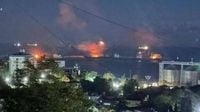In the shadowy hours of recent nights, Ukraine’s long-range drones have been rewriting the rules of war, striking deep into Russian territory and hitting targets once thought untouchable. These attacks, carried out by a fleet of domestically produced unmanned aerial vehicles, have targeted oil refineries, power substations, and strategic military infrastructure across Russia, marking a dramatic escalation in the conflict’s geography and intensity.
The most recent wave of strikes unfolded on the night of November 2, 2025. According to local Russian sources and corroborated by Ukrainian officials, swarms of Ukrainian drones descended on energy infrastructure in the Kursk and Lipetsk regions. Residents of Zheleznogorsk, Kursk, reported seeing at least 15 attack drones buzzing overhead before a fire broke out at a 330 kV electrical substation. The resulting damage plunged parts of the city into darkness and disrupted water supplies—a stark reminder that the war’s front lines now stretch far beyond Ukraine’s borders (as reported by local Telegram channels and summarized by Espreso TV).
The attacks didn’t stop there. In Usman, Lipetsk region, another drone strike hit a crucial 220 kV traction substation, disrupting the railway between Lipetsk and Voronezh. These substations, once considered safe, now find themselves in the crosshairs of Ukraine’s expanding drone campaign. The strategic significance is clear: by targeting energy and logistics hubs, Ukraine aims to degrade Russia’s ability to supply its war effort and maintain domestic stability.
Ukraine’s Foreign Minister, Andrii Sybiha, minced no words about the rationale behind these operations. “Ukraine’s long-range strength is key to forcing Russia to end the war. The longer we can reach, the shorter the war will be,” he declared in a public statement on November 2. Sybiha highlighted that successful strikes on Russian military targets are increasing weekly, a testament to what he described as a “well-calculated, precise, and smart campaign to degrade the Russian war machine and force Moscow to end the war sooner.” He also called on international partners to increase investments in Ukraine’s burgeoning defense sector, arguing, “We have the technology and ability to produce more strength, but we need more investments to scale it up.”
That technology is already making a tangible impact. At a secret assembly site somewhere in rural Ukraine, teams of engineers and operators work through the night, piecing together drones from parts manufactured in a dispersed network of workshops. The Liutyi drone—its name meaning “fierce” in Ukrainian—has become a symbol of this homegrown ingenuity. With a range now reaching up to 1,000 kilometers, double what it was a year ago, these drones are striking further and harder than ever before, according to a detailed report by the BBC.
Since the summer of 2025, Ukraine’s drone campaign has ramped up dramatically. The BBC notes that Ukrainian drones have struck 16 major Russian refineries, representing about 38% of Russia’s nominal refining capacity. While most plants resume operations within weeks—thanks to Russia’s idle capacity and fuel surpluses—the cumulative effect is unmistakable. President Volodymyr Zelensky stated at a Kyiv briefing, “We believe they’ve lost up to 20% of their gasoline supply—directly as a result of our strikes.” The International Energy Agency corroborates this, estimating that repeated drone attacks have cut Russia’s refining capacity by around 500,000 barrels per day, leading to domestic fuel shortages and curbed exports of diesel and jet fuel.
Perhaps most importantly, these strikes are now largely autonomous. As Western allies hesitate to provide long-range weapons—such as the US Tomahawk missiles—Ukraine has taken matters into its own hands. Zelensky revealed that “90-95% of long-range strikes deep inside Russia are now carried out with Ukrainian-made weapons,” with only limited use of British and French missiles. This independence allows Kyiv to launch attacks without waiting for foreign approval, a crucial advantage as the conflict drags on.
The cost-effectiveness of Ukraine’s drone program cannot be overstated. The Liutyi, for example, can be produced for as little as $55,000, a fraction of the price of traditional missiles. This has enabled Ukraine to maintain a steady tempo of attacks, even as fewer than 30% of drones reach their intended targets—a reality that demands meticulous planning and, tragically, comes with the loss of operators’ lives. “War has fallen to our generation so that we can fight for our kids and they can live in a free democratic country,” said a Ukrainian drone commander known by the call sign Fidel. “We are currently obtaining experience that will be used by every country in the world and we are paying the price with our lives and the lives of our friends.”
The strikes have not been without dramatic moments. On the night of November 2, drones struck oil facilities at the Tuapse port on Russia’s Black Sea coast. Eyewitness videos showed flames engulfing an oil tanker, while authorities confirmed damage to port infrastructure. The Security Service of Ukraine (SBU) took responsibility for the attack, stating the goal was to “limit Russia’s oil income, a key source of funding for its war in Ukraine,” as reported by the Kyiv Post. The Tuapse refinery, owned by Rosneft, processes about 12 million tons of crude oil annually and is a vital export terminal. Previous Ukrainian strikes in March, July, and September had already forced parts of the facility offline and prompted Russia to reroute production.
It’s not just the oil sector feeling the heat. On October 31, the Ukrainian Navy used Neptune cruise missiles to hit energy infrastructure in Russia’s Bryansk and Oryol regions, targeting facilities that supplied power to military enterprises. Another strike on Oryol was reported on November 2, though the results remain unclear.
All of this forms part of a broader Ukrainian strategy: attrition by logistics. By forcing Russia to defend a sprawling array of targets and reroute supplies, Kyiv seeks to stretch Moscow’s resources thin and sap its ability to sustain large-scale operations. As Adriano Bosoni, director of analysis at RANE, told the BBC, “For most of the war, Russia operated on the assumption that its own territory was safe. That’s no longer the case.”
Yet, for all the tactical successes, the campaign is not without its limits. Western analysts caution that while the drone strikes have caused serious disruptions, they have not crippled Russia’s energy sector. Most refineries return to operation within weeks, and Russia’s overall oil production—and global prices—remain stable. Still, the psychological and economic impact is real, with rationing and fuel shortages reported in several Russian regions.
Back in Ukraine, the message from officials is clear: the campaign will continue. President Zelensky has vowed to keep targeting Russian oil infrastructure to undermine the Kremlin’s ability to finance its war. Foreign Minister Sybiha, meanwhile, continues to urge international partners to “build in Ukraine and build with Ukraine,” promising that those who support Ukraine’s defense sector now will reap future benefits for their own security.
As Ukraine’s drones continue to pierce deeper into Russian territory, the balance of power in this grinding conflict is shifting—one strike, one drone, one night at a time.





